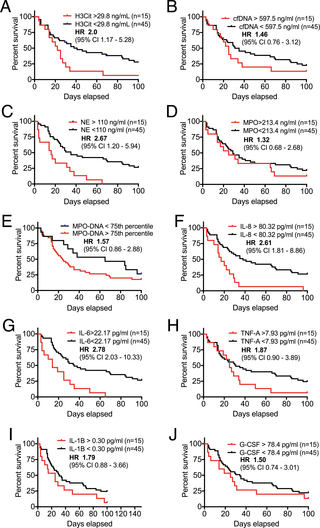PLOS ONE ( IF 2.9 ) Pub Date : 2018-01-11 , DOI: 10.1371/journal.pone.0191231 Charlotte Thålin , Staffan Lundström , Cedric Seignez , Maud Daleskog , Annika Lundström , Peter Henriksson , Thomas Helleday , Mia Phillipson , Håkan Wallén , Mélanie Demers

|
Citrullinated histone H3 (H3Cit) is a central player in the neutrophil release of nuclear chromatin, known as neutrophil extracellular traps (NETs). NETs have been shown to elicit harmful effects on the host, and were recently proposed to promote tumor progression and spread. Here we report significant elevations of plasma H3Cit in patients with advanced cancer compared with age-matched healthy individuals. These elevations were specific to cancer patients as no increase was observed in severely ill and hospitalized patients with a higher non-malignant comorbidity. The analysis of neutrophils from cancer patients showed a higher proportion of neutrophils positive for intracellular H3Cit compared to severely ill patients. Moreover, the presence of plasma H3Cit in cancer patients strongly correlated with neutrophil activation markers neutrophil elastase (NE) and myeloperoxidase (MPO), and the inflammatory cytokines interleukin-6 and -8, known to induce NETosis. In addition, we show that high levels of circulating H3Cit strongly predicted poor clinical outcome in our cohort of cancer patients with a 2-fold increased risk for short-term mortality. Our results also corroborate the association of NE, interleukin-6 and -8 with poor clinical outcome. Taken together, our results are the first to unveil H3Cit as a potential diagnostic and prognostic blood marker associated with an exacerbated inflammatory response in patients with advanced cancer.
中文翻译:

瓜氨酸组蛋白H3可作为晚期癌症患者新的预后指标
瓜氨酸化的组蛋白H3(H3Cit)在核染色质的嗜中性粒细胞释放(称为嗜中性粒细胞胞外捕获物(NETs))中起着重要作用。NETs已显示出对宿主的有害作用,最近被提出促进肿瘤的进展和扩散。在这里,我们报告与年龄匹配的健康个体相比,晚期癌症患者的血浆H3Cit显着升高。这些升高是癌症患者特有的,因为在非恶性合并症较高的重症和住院患者中未观察到升高。癌症患者中性粒细胞的分析显示,与重症患者相比,细胞内H3Cit阳性的中性粒细胞比例更高。而且,癌症患者血浆H3Cit的存在与中性粒细胞激活标志物中性粒细胞弹性蛋白酶(NE)和髓过氧化物酶(MPO)以及已知诱导NETosis的炎性细胞因子白细胞介素6和-8密切相关。此外,我们显示,高水平的循环H3Cit强烈预测了我们这一队列的癌症患者的临床预后较差,短期死亡率增加了2倍。我们的结果也证实了NE,白介素6和-8与不良临床预后的关联。综上所述,我们的结果首次揭示了H3Cit作为潜在的诊断和预后性血液标志物,与晚期癌症患者炎症反应加重有关。我们表明,高水平的循环H3Cit强烈预测了我们队列中的癌症患者的不良临床预后,其短期死亡率风险增加了2倍。我们的结果也证实了NE,白介素6和-8与不良临床预后的关联。综上所述,我们的结果首次揭示了H3Cit作为潜在的诊断和预后性血液标志物,与晚期癌症患者炎症反应加重有关。我们表明,高水平的循环H3Cit强烈预测了我们队列中的癌症患者的不良临床预后,其短期死亡率风险增加了2倍。我们的结果也证实了NE,白介素6和-8与不良临床预后的关联。综上所述,我们的结果首次揭示了H3Cit作为潜在的诊断和预后性血液标志物,与晚期癌症患者炎症反应加重有关。













































 京公网安备 11010802027423号
京公网安备 11010802027423号